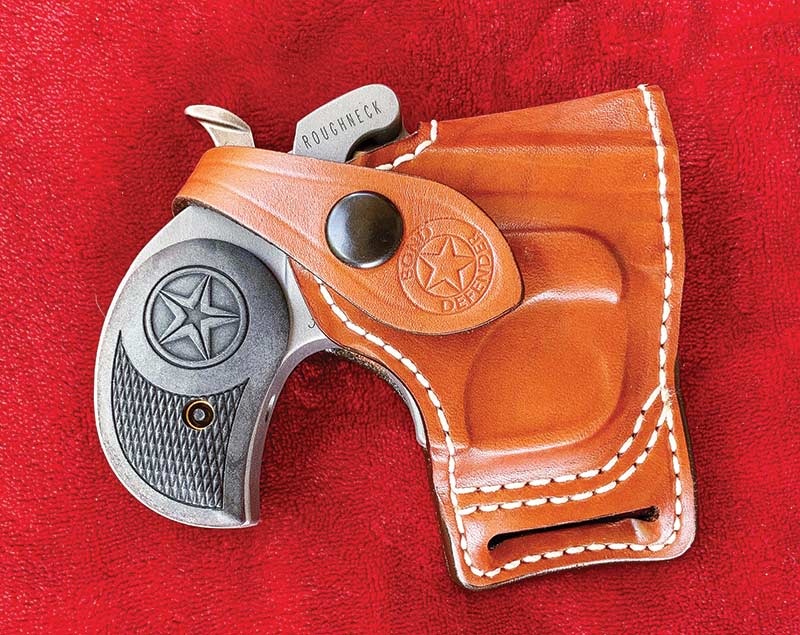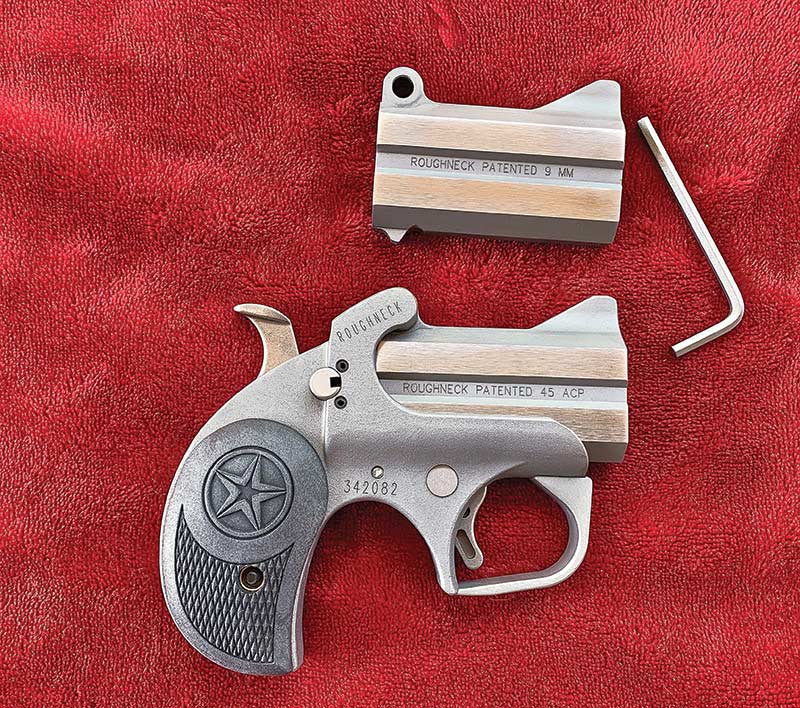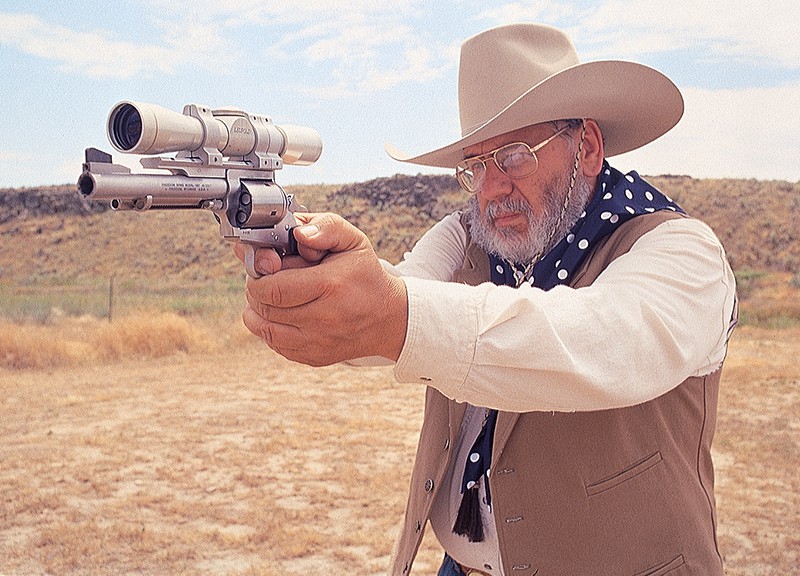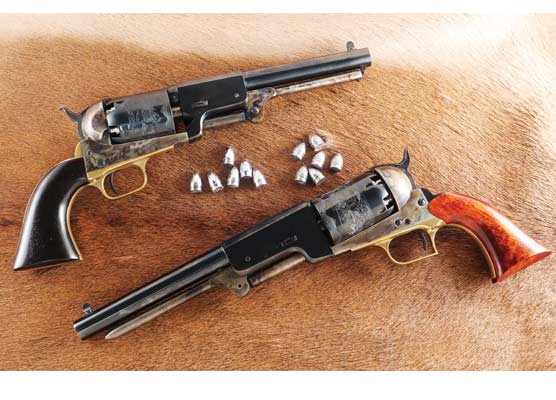Bond Arms Roughneck
For a little over 30 years, I was the editor of S.W.A.T. Magazine. Although the focus of the magazine was basically “tactical” firearms, my heart has always been with older guns.
As an example, I’ve written several articles for GUNS on century-old shotguns. I have attended classes at Gunsite with a #3 Schofield and a Single Action Army.
The Remington over-under, single-action Derringer has been seen in numerous Western movies and television shows. The little guns were popular in real life as well, with Remington manufacturing more than 150,000 over-under double-barreled guns from 1866 until the end of their production in 1935. The gun was chambered in .41 Short and had a muzzle velocity of 425 feet-per-second (fps) — quite anemic by modern standards.
Bond Arms
Bond Arms is a well-established firearms manufacturer specializing in over-under handguns, commonly called derringers. Originally organized under the name Texas Armory, the company became incorporated as Bond Arms in 1995 with the idea the Remington Model 95 over-under, single-action derringer could be converted into a modern defensive handgun. Using modern manufacturing methods, and constructed entirely from stainless steel, Bond Arms redesigned the barrels and frame to safely fire modern calibers. This makes for a pistol that’s both strong and durable.
Bond Arms has become prominent in the firearms industry for having a premium fit and finish to every gun they produce. To get to that level of aesthetic quality, it takes a lot of time and work. Literally every part is sanded, followed by an enormous amount of time polishing and hand finishing to the quality finish that Bond Arms is known for.
Once the guns are shot and all functions work as they should, the QC staff goes the measure to find every cosmetic flaw, scratch, ding, or pit or anything else not passing inspection. On occasion, the same gun may go through the same process three or four times until it passes QC! Bond Arms has taken this process and trimmed it down to create a gun with the robust qualities of their other models without all of the frills.
The Roughneck
With the Roughneck and Rough N’ Rowdy series still using the same quality parts, a minimal clean up and deburr is performed to make sure there are no sharp edges followed by a bead blast finish.
Bond Arms can build four to five Roughnecks in the same time as it takes to build one Texas Defender. This is a huge amount of savings on labor, allowing them to pass those savings down to the consumer. The Roughneck has a suggested retail price of only $269. Compare this to the price of a Texas Defender that goes for $543.
In short, by still using the same quality of parts, Bond Arms came up with ways to reduce cost, but still build quality, reliable guns.
Specs
The Roughneck is built with a 2.5″ barrel chambered for 9mm, .357/.38, .380 ACP or .45 ACP. It has a front blade and a fixed rear notch sight with hard rubber grips. Weight is 19 oz. and length is 4.5″. Additional features of the Roughneck include:
• Stainless steel double-barrel and frame
• Compatible with all standard Bond Arms barrels
• Patented rebounding hammer
• Retracting firing pins
• Cross-bolt safety
• Spring-loaded, cammed locking lever
Initial Thoughts
Even though this is not Bond’s top-of-the-line model, I was impressed with the workmanship and the small gun locked up as tight as a vault door in a bank.
My personal Roughneck is chambered for .45 ACP and I have a set of 9mm barrels as well.
According to Bond Arms, since a Roughneck does not go through the usual sanding and polishing of the frame, tiny casting imperfections and rough areas may be present. These flaws would never be acceptable on other Bond models. The fine line between the trigger guard and frame on my gun was barely visible, but no other blemishes were found.
Unlike some Bond Arms models, the Roughneck does not have extractors. This would be superfluous for either .45 ACP or 9mm as they are rimless cartridges. A small cutout at the breech end of the barrels allows for manual extraction of fired rounds. Not to worry, however, because the case is fully supported and only a very small amount of the case head and rim protrudes into the notch.
Unlike the original derringers, Bond Arms guns have a trigger guard. My first thought was this is unnecessary, but upon reflection, it’s a darned good idea. It’s quite possible in a moment of carelessness someone would try to holster a cocked gun with the safety off, resulting in injury or possibly death. While the trigger guard can be detached by removing a single screw in the frame, it is not recommended either by Bond Arms or this scribe.
According to studies, between 70% to 95% of the world’s population is right-handed. Among them are those rare ambidextrous individuals who can use either hand equally well. All Bond Arms derringers are perfect for a right-hander as all operations — barrel release, safety removal and cocking — can be performed without releasing a firing grip.
To keep my finger off the trigger until I’m ready to fire, I have always been taught to touch the firearm’s frame, not the trigger guard. A “startle response” will result in an involuntary tightening of the hand and could result in the trigger being pulled.
The frame on the Roughneck is only about a half-inch wide and radiused, which can allow the finger to unintentionally slip onto the trigger. I found a very secure location to place my finger is in the groove between the barrels.
Firing The Roughneck
I was curious how much velocity would be lost from the short barrels and decided to take along my PACT chronograph. Two loads I felt would be good defensive rounds were a 200-grain lead SWC for the .45 and the 100-grain Black Hills HoneyBadger +P for the 9mm.
Control pistols for comparison velocities were a Kimber Custom .45 and a Nighthawk Hi-Power for the 9mm. The full-size Kimber averaged 818 fps and the .45 Roughneck lost an average of 117 fps while the Hi-Power averaged 1,247 fps and 9mm barrels lost only 98 fps.
The fat .45 SWC will likely be able to get the job done and the 9mm HoneyBadger was still in excess of Mach 1 and should be able to perform as designed.
In terms of accuracy, at seven yards the top barrel shot to point of aim with the bottom barrel’s rounds hitting about 4″ to 5″ lower, although groups from each barrel were about 1 ½”. The same thing will occur with an over-under shotgun or rifle since they are obviously not on the same plane. The disparity will become larger as distances increase.
This does not mean you can’t make a hit at 25 yards. You just have to practice to know where the bullet(s) will impact. And if you’re carrying the Roughneck for protection, you should be practicing.
Recoil is subjective as some are more sensitive than others. As for myself, I found the gun very pleasant to shoot with felt minimal recoil.
Although a single-action, the trigger pull is heavy. I found the best way for me was to place the first joint of my finger on the trigger and pull smoothly straight through like a double-action revolver.
I won’t be giving up my semi-auto pistols, but now they will be backed up by a Bond Arms Roughneck in a pocket.











